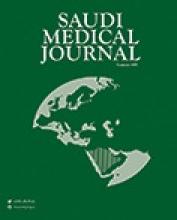Abstract
OBJECTIVE: To review our experience with periductal mastitis and address the clinical characteristics, management and outcome.
METHODS: A retrospective study was carried out at Princess Basma Teaching Hosptal, Irbid, Jordan. Thirty-five patients with the diagnosis of periductal mastitis from the year 1994 through to 2000 were reviewed. Patients presenting with periareolar non-lactating inflammation, a periareolar inflammatory mass, abscess, mammary fistula, or nipple inversion were included in the study.
RESULTS: The mean age was 33 years. Pain and pus nipple discharge were the most frequent symptoms. A periareolar mass, induration, mammary duct fistula, or nipple deformity were found in 49%, 43%, 11%, and 34% of the cases. Twenty-six percent were smokers. This ratio increased to 75% among patients with mammary fistulas. Three patients had synchronous skin lesions; the same bacterial strains were isolated from both lesions. This may suggest that breast manipulation, transferring bacteria to the breasts from other parts of the body, might play a role in the etiology. Broad spectrum antibiotics treated all patients. Surgery was necessary for 32 (91%) patients.
CONCLUSION: Periductal mastitis is rare and affects non-lactating women during their reproductive life. Etiologically, periductal mastitis is related to bacterial infection and smoking. It mimics other serious breast disorders including carcinoma. On the contrary, duct ectasia affects women between the ages of 42-85 years and is considered an ageing phenomenon which is not related to sepsis or smoking.
- Copyright: © Saudi Medical Journal
This is an open-access article distributed under the terms of the Creative Commons Attribution-Noncommercial-Share Alike 3.0 Unported, which permits unrestricted use, distribution, and reproduction in any medium, provided the original work is properly cited.






